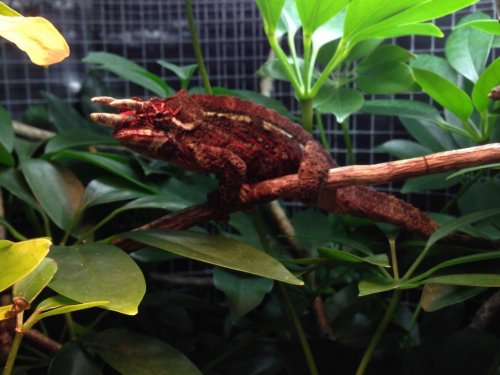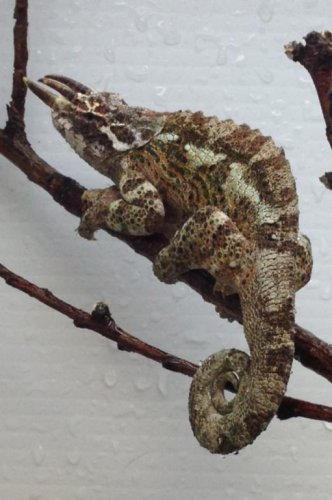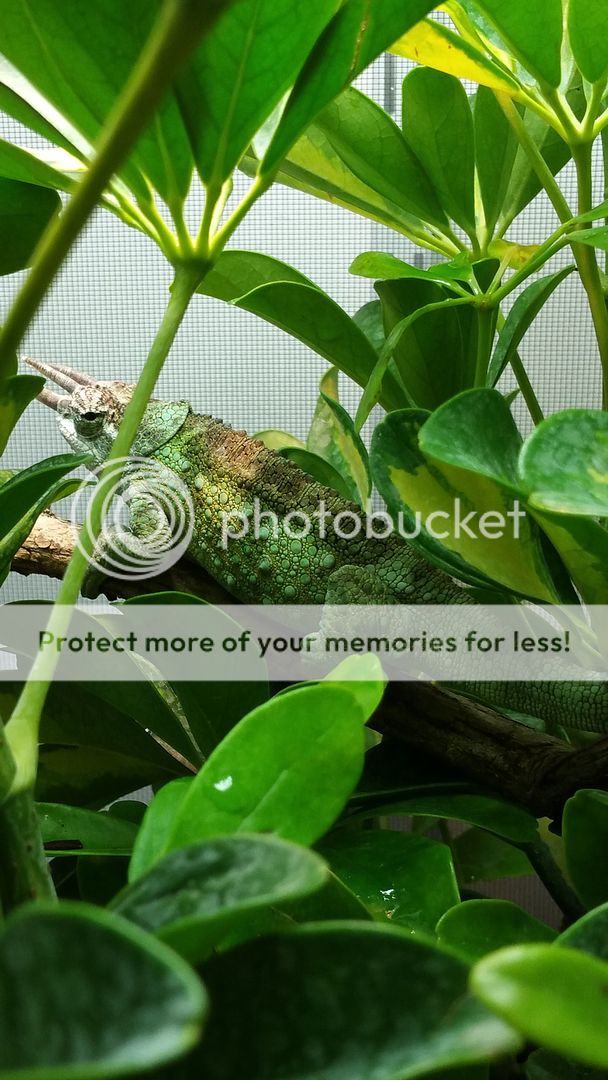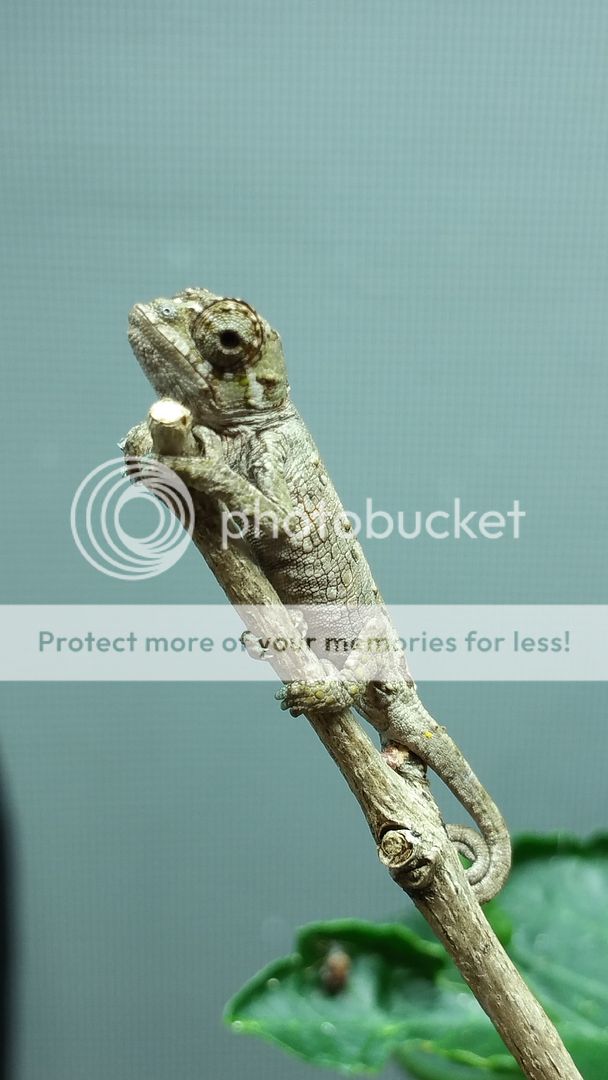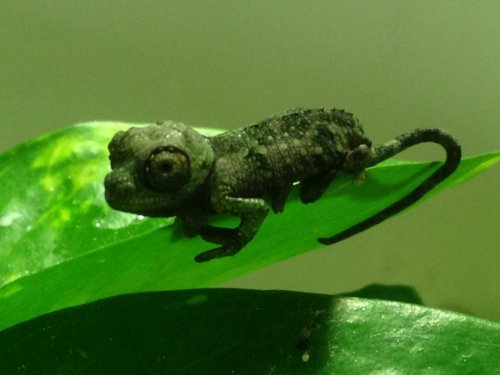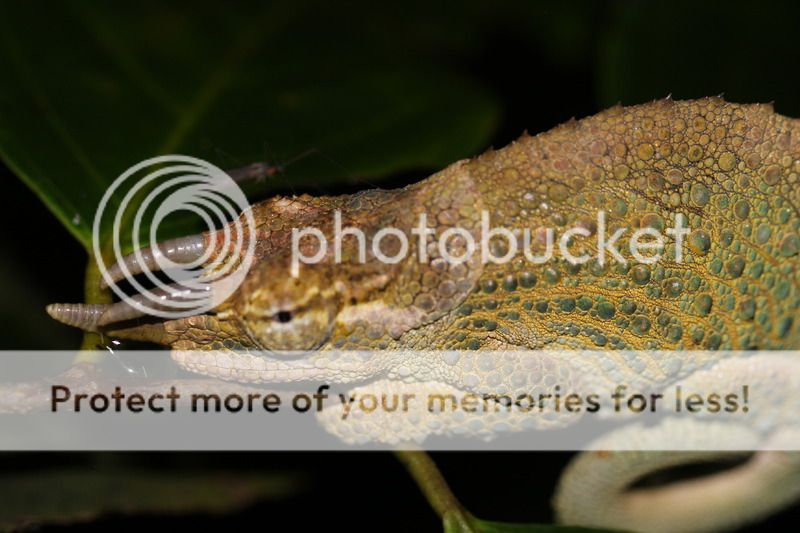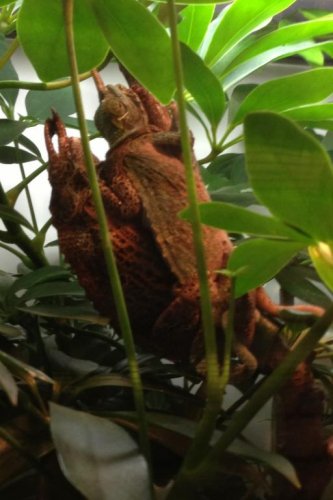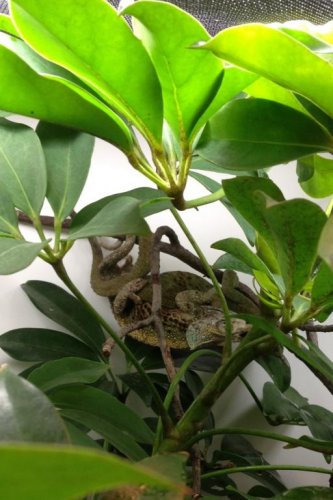Navigation
Install the app
How to install the app on iOS
Follow along with the video below to see how to install our site as a web app on your home screen.
Note: This feature may not be available in some browsers.
More options
You are using an out of date browser. It may not display this or other websites correctly.
You should upgrade or use an alternative browser.
You should upgrade or use an alternative browser.
Calling all T. werneri keepers
- Thread starter GCash
- Start date
GCash
Avid Member
Thanks guys! They are amazing and underrated for sure. I liked seeing the individual variation in the quad thread so much that I wanted to see what else these guys have to offer since my two males are so different. The picture that drew me in was of a male with black horns and quite stunning. The babies surprised me even more. I also wouldn't mind if this thread pulled together the people working with them and show the portion of community that's unaware just how beautiful they are. So bring on the pics!
pamnsam94
Established Member
Looking forward to following this thread. Although I haven't kept them, I've come so close to pulling the trigger and getting some. I hope I haven't missed the boat with WC ones (for genetic diversity sake) because I don't see as many for sale right now as I did earlier in the year. Because of their horns, flaps and interesting scalation, I'm surprised they haven't gained more of a following.
little leaf
Avid Member
Motherlode Chameleon
Chameleon Enthusiast
Trioceros werneri are a neat three horned species. As well they are a "Flap Jack" species that is a neat trait as well. I have found they have done good in relatively high humidity. Though they are not the biggest fan compared to other Trioceros species when it comes to being wet. These are a couple recent photos of my sub adult Trioceros werneri, a male and female.


Best Regards
Jeremy A. Rich

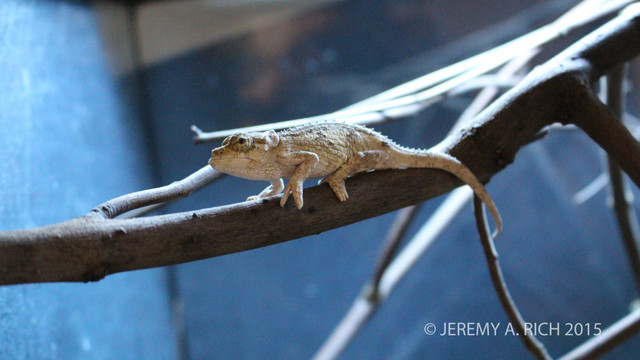
Best Regards
Jeremy A. Rich
Last edited:
GCash
Avid Member
Good looking Werner's guys! I find it hard to believe with as many of these as I've seen offered for sale over the last year and a half, we are the only keepers representing this species on the forum. Carl, I know you and Jeremy have had several full clutches, what are your views on how this species is faring in the states? I haven't been pushing the breeding of mine because it seemed like the market was rather flooded as it was, but what Perry said may just be a wake up call that I need. I hope it's just a seasonal lull he's perceiving but you can't really take anything for granted these days. Maybe we should begin thinking about working together to establish a sustainable population of these guys, however limited, just in case. They truly are amazing and rather unique. If people like Jackson's because they look like "miniature triceratops", they surely haven't seen a Werner's displaying with their occipital lobes fully flared. I need to take more pics. Until then, here's the first baby I welcomed since I returned to keeping who's name is "Chargrilled"(for the color she turned whenever we tried to take her picture, it was better than "Turd on a stick"). She's my avatar.
Thanks to everyone for participating.
Thanks to everyone for participating.
Attachments
Trace
Captain Awesome
I’m not keeping any Trioceros werneri at the moment but they are one of my favourites! For that reason I can not be part of any potential breeding group, combined with being on the wrong side of the border but I hopefully can add some husbandry and breeding insights if needed.
Here are some gratuitous pix from the past. Small, knobbly, horns, flaps and chock full of personality. What’s not to love?



Here are some gratuitous pix from the past. Small, knobbly, horns, flaps and chock full of personality. What’s not to love?



CarlC
Established Member
My feelings on a potential captive population in the states is its never going to happen. Just like 99% of the species available it will always just be a few keepers working successfully with this species.
As for T. werneri's status in the wild the species faces many challanges. It only receives minimal protection in its known ranges. The strictest protection at this time is found in Kihansi Gorge. It is also possible that the species is found in Udzungwa National Park but so far no populations have been found.
The protection is decided by the villages that the forest patches are located near. The species is almost always found high up on tree's usually 3m and higher. Typically they are found in the fringe of the forest on tree's located near or above a moving water source. Many generations live on the same tree so if that single tree is felled the possibility is there to remove a great number in one shot.
The werneri we see in the trade are collected from Mufindi District. In this area the greatest populations are found. Tea plantations, timber harvest, and sustenance farming are all putting pressure on the species.
Werneri populations in the Nguru and Uluguru Mountains are not nearly as dense and typically more scattered. These populations are also where you see the greatest differences in the species. Work is currently being done to decide if these varients are seperate species.
Carl
As for T. werneri's status in the wild the species faces many challanges. It only receives minimal protection in its known ranges. The strictest protection at this time is found in Kihansi Gorge. It is also possible that the species is found in Udzungwa National Park but so far no populations have been found.
The protection is decided by the villages that the forest patches are located near. The species is almost always found high up on tree's usually 3m and higher. Typically they are found in the fringe of the forest on tree's located near or above a moving water source. Many generations live on the same tree so if that single tree is felled the possibility is there to remove a great number in one shot.
The werneri we see in the trade are collected from Mufindi District. In this area the greatest populations are found. Tea plantations, timber harvest, and sustenance farming are all putting pressure on the species.
Werneri populations in the Nguru and Uluguru Mountains are not nearly as dense and typically more scattered. These populations are also where you see the greatest differences in the species. Work is currently being done to decide if these varients are seperate species.
Carl
Motherlode Chameleon
Chameleon Enthusiast
My feelings on a potential captive population in the states is its never going to happen. Just like 99% of the species available it will always just be a few keepers working successfully with this species.
As for T. werneri's status in the wild the species faces many challanges. It only receives minimal protection in its known ranges. The strictest protection at this time is found in Kihansi Gorge. It is also possible that the species is found in Udzungwa National Park but so far no populations have been found.
The protection is decided by the villages that the forest patches are located near. The species is almost always found high up on tree's usually 3m and higher. Typically they are found in the fringe of the forest on tree's located near or above a moving water source. Many generations live on the same tree so if that single tree is felled the possibility is there to remove a great number in one shot.
The werneri we see in the trade are collected from Mufindi District. In this area the greatest populations are found. Tea plantations, timber harvest, and sustenance farming are all putting pressure on the species.
Werneri populations in the Nguru and Uluguru Mountains are not nearly as dense and typically more scattered. These populations are also where you see the greatest differences in the species. Work is currently being done to decide if these varients are seperate species.
Carl
Carl
I think this species has an outside shot at becoming established in the reptile trade, even if it is only one or two keepers here and there with 2-5 pairs. People seem to like them as they have many desirable traits that separates them from many other chameleons species. This even though this species may never become the most popular species in the hobby.
As for the situation of this species in the wild, contemporary agricultural and conservation biology practices have to be asserted. These contemporary practices have got to happen if we want to change the loss of wildlife habitat (forestry), sustainability of the land for agriculture (prevent agricultural encroachment), and conserves these tropical lands long term. If conservation of chameleon habitat and prevention of non sustainable agricultural practices do not happen, the problems that we are watching now in tropical countries that have got chameleons populations are likely to continue. This is a problem that is happening not just in Tropical Africa. This is a difficult problem that is happening in many Tropical countries around the globe.
Best Regards
Jeremy A. Rich
Last edited:
GCash
Avid Member
Not what I was wanting to hear Carl, but thanks for the honesty. Hopefully, like Jeremy mentioned, we we can achieve at least a small population that can get us a little ways into the future if the keepers currently working with them keep a few pairs each going. Wow. What happened? It's hard to believe how much has changed with the chameleon keeping community since I took my leave of absence. I remember when they published a list of keepers and all the species they were currently working with, appreciating the diversity and challenge. Phone numbers and all, because it was before the Internet was full steam ahead. My smartphone just took it upon itself to capitalize Internet, BTW. I guess this is what happens in the "information" age. One finds that the rainbow colored chameleon is called a panther chameleon and does a search and then stays within that bubble(speaking very generally, of course). Back when you had to rely on books, there would be a number of different species descriptions you would be exposed to and have a chance to find the beauty and fall in love with them all. I'm a little heartbroken every time I hear "Wow, I've never seen a chameleon like that before. What breed is it?", when its a species that would be included in any good chameleon book worth it's salt. Don't get me wrong, the Internet can obviously have its advantages and I believe Panthers are gorgeous, I just can't understand how a chameleon that's bred in such numbers and are so commonplace can still be sold for $300 in the corporate pet chains like I've heard, while 90% or more of the other species, that are at least as equally amazing, are threatened with not only never being seen in captive populations again, but in their natural range as well. Potentially lost forever. It drives me crazy when something I deeply care for is seemingly being done more for monetary reasons than in and of itself. Sorry about the rant. I really wanted to post it in my "Calling all montium keepers" thread but was afraid no one would see it. Case in point. I just had to unload some frustrations. Please forgive.
Thanks for sharing your field observations and picture, Carl.
Thanks for sharing your field observations and picture, Carl.
Motherlode Chameleon
Chameleon Enthusiast
Not what I was wanting to hear Carl, but thanks for the honesty. Hopefully, like Jeremy mentioned, we we can achieve at least a small population that can get us a little ways into the future if the keepers currently working with them keep a few pairs each going. Wow. What happened? It's hard to believe how much has changed with the chameleon keeping community since I took my leave of absence. I remember when they published a list of keepers and all the species they were currently working with, appreciating the diversity and challenge. Phone numbers and all, because it was before the Internet was full steam ahead. My smartphone just took it upon itself to capitalize Internet, BTW. I guess this is what happens in the "information" age. One finds that the rainbow colored chameleon is called a panther chameleon and does a search and then stays within that bubble(speaking very generally, of course). Back when you had to rely on books, there would be a number of different species descriptions you would be exposed to and have a chance to find the beauty and fall in love with them all. I'm a little heartbroken every time I hear "Wow, I've never seen a chameleon like that before. What breed is it?", when its a species that would be included in any good chameleon book worth it's salt. Don't get me wrong, the Internet can obviously have its advantages and I believe Panthers are gorgeous, I just can't understand how a chameleon that's bred in such numbers and are so commonplace can still be sold for $300 in the corporate pet chains like I've heard, while 90% or more of the other species, that are at least as equally amazing, are threatened with not only never being seen in captive populations again, but in their natural range as well. Potentially lost forever. It drives me crazy when something I deeply care for is seemingly being done more for monetary reasons than in and of itself. Sorry about the rant. I really wanted to post it in my "Calling all montium keepers" thread but was afraid no one would see it. Case in point. I just had to unload some frustrations. Please forgive.
Thanks for sharing your field observations and picture, Carl.
Gene
We may not see huge breeding operations that much, however I think they are not gone at all. It is just part of the chameleons keeping hobby that someone becomes obsessed with a genus or species and decides to mostly breed that genus or species. However if that happens that by no means means they are not allowed to keep a couple pairs or more or a conservative sized group of another species or genus that the keepers are interested about. How about Trioceros or Bradypodion? This situation (that there is a large selection of chameleons to choose from) happens a lot in the chameleon keeping community and is one of the strong points of this hobby/study. As you were saying there is such a selection to choose from such as the choice of keeping Trioceros werneri or Trioceros montium why not keep both if you have more conservative breeding groups and occasionally collaborative with other breeders? For the most part people are keeping more than one species of chameleon and sometimes many genera of chameleons. However there are people that downsize from many species to concentrate just one species such as Calumma parsonii parsonii, Furcifer pardalis, Kinyongia matschiei, Kinyongia multituberculata, Trioceros quadricornis quadricornis, Chamaeleo calyptratus and others. This is a trend that is not going to stop.
Best Regards
Jeremy A. Rich
Last edited:
GCash
Avid Member
OK guys. I had this go down today. My oldest/largest pair showed receptivity and follow-through. The first time I've found that she's been willing to mate since I've had her even though she's dropped slugs twice. I started thinking she's a little past her prime but her displaying and communication with the male gives me hope. Keeping my fingers crossed!
Attachments
GCash
Avid Member
...And then, wondering if something was in the air with the weather change we've been having, this happened. She didn't seem as receptive as the older female, but he was so determined and quick that I couldn't stop him, and neither could she, but she didn't contest as much as she could have, so I let nature take it's course. Once engaged, she settled down and the copulation lasted for quite a while. Hopefully if we were outside of her window, we were early and she'll be ready for her next litter. Two pairs matings in one day. Other fingers crossed.
Attachments
Similar threads
- Replies
- 89
- Views
- 4K

